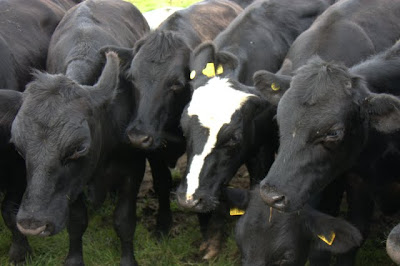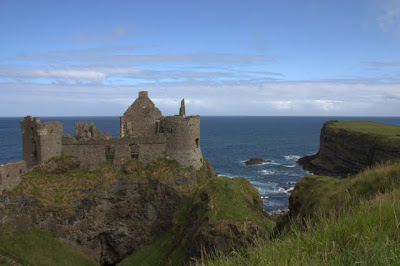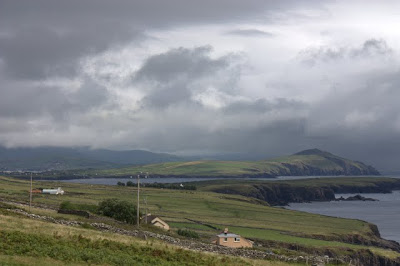Table Mountain and the Mother City
“During the many years of incarceration on Robben Island, we
often looked across Table Mountain at its magnificent silhouette…
To us on Robben Island, Table Mountain was a beacon of hope. It
represented the mainland to which we knew we would one day return.”
– Nelson Mandela
When I think back to our time in Cape Town, Table Mountain dominates my memories much the same way that it dominates Cape Town’s sky line. It cradles the city and protects it, while it rises above the city and inspires.

View of Table Mountain from Robben Island - the island where Nelson Mandela spent 18 years in incarceration
You can catch glimpses of Table Mountain from many neighborhoods in town. It is not off in the distance; its presence is immediate. Its flat top is often covered with a thick fog, which Cape Townians dubbed the “tablecloth.”
You can tell that Cape Town residents are proud of their mountain; everyone we met asked us if we had gone to the top yet. A couple of days after we arrived, we took the revolving cable car up to the top, adding it to the list of mountains we have summited in our lifetime. (Yes, our definition of summit is very liberal; don’t judge us). We spent a few hours exploring the mountain’s flat top and peeking over the sides to see the city and ocean below.

Sean and me at the top, with a view of Green Point Stadium, which was built for the World Cup, and the neighborhood of Green Point, which is where we stayed.
Cape Town’s position of being nestled between Table Mountain and the Atlantic Ocean, not to mention its cosmopolitan restaurants, shops and cafes or its temperate climate (it was supposed to be winter while we were there, for crying out loud!) makes Cape Town definitely live up to its hype.
Cape Town Sunset…
…over the Atlantic Ocean.
Happy Sunday and Go Steelers! No listening to the game this week for us – we’re in South Korea now, which means the game will happen at 2:00 a.m. our time.
Going Up the Country
I’m going up the country, baby, don’t you wanna go
I’m going up the country, baby, don’t you wanna go
I’m going to some place where I’ve never been before
I’m going, I’m going where the water tastes like wine
I’m going where the water tastes like wine
We can jump in the water, stay drunk all the time
I’m gonna leave this city, got to get away
I’m gonna leave this city, got to get away
All this fussing and fighting, man, you know I sure can’t stay
Now, Baby, pack your leaving trunk, you know we got to leave today
Just exactly where we going I can not say
But we might even leave the U.S.A.
‘Cause it’s a brand new game, and I want to play
No use of you running or screaming and crying
‘Cause you got a home as long as I’ve got mine– Going Up the Country, Canned Heat
Due to my sheep obsession, I talked Sean into spending two nights on a working beef and sheep farm in County Armaugh in Northern Ireland after leaving Belfast. The actual quality time with sheep was not what I was expecting. We only met two lambs and sadly, their days were numbered.
It turns out visiting the farm was interesting for other reasons. Had we not gone into the country, I would have continued to assume that the Troubles only touched upon people living in the cities. That was far from the case. Bombings took place in the country, as well. Some took place long ago, in the seventies: the pub up the road from the B&B had been bombed, and there was remains of a car bomb on the farm where we stayed. More troubling was the more recent activity. We ate dinner and had a few pints in the neighboring town, Keady. I never would have suspected any problems there, but several bombs had been planted in the previous few months. Much of the activity is aimed at police. When we were standing on the road, chatting with the owner of the B&B, he waved at a passing car. That was the local police, he told us. They wear armored vests and drive in unmarked cars because too many people try to shoot at them. He said this matter-of-factly, like this was normal, whereas Sean and I were surprised, once again, how the problems in Northern Ireland are not dormant.
On a lighter note, we also saw and did some things that only happen in the country.
Went to the combination general store/post office/public phone/gas station:
Saw road bowling, something Sean had saw previously on the Travel Channel:
Made farm friends:
Saw a new, gangly, awkward, adorable baby mare:
Held a chicken:
Got up close and personal with hungry cows before moving them to a new pasture:
And saw beautiful rural scenery:
Sometimes you just gotta go where the water tastes like wine.
Touring the Antrim Coast
The northernmost coast of Northern Ireland, somewhat in between Derry and Belfast, is known as the Antrim Coast. In certain spots, it is only 12 miles away from Scotland. The coast is chock full of goodies, not even counting the many random places we stopped to take in the view. I don’t normally bore you with a play by play of our days, but some days are so awesome they are worth checking out step by step. Come along on a tour with us:
1. First up is Dunluce Castle. Perched on cliffs that tower over the sea, the castle has lain in ruins since it was pillaged in the 16th century. If you own the actual record recording of Led Zeppelin’s Houses of the Holy, flip open the album. The picture in the centerfold is Dunluce Castle. When I was younger, I hung the album cover open to the center picture on my bedroom wall, never realizing that I would someday visit the castle depicted.
2. Next, we toured Bushmill’s Distillery. Naturally, the perfect start to a day of driving is drinking whisky. Since neither of us are whisky fans, we just tasted small amounts of the 10 and 12 year reserves. Smooth, but not smooth enough.
3. Then, we took a short walk along the ocean to visit the most visited attraction in Northern Ireland: Giant’s Causeway. The causeway is a bizarre series of basalt formations. The most famous part is the formations that are shaped like octagons (?) and jet out of the ground at various lengths. Flat on top, you can hop from one to the other. Legend has it that they were created by Finn McCool, a giant who used them as stepping stones to get to Scotland to resuce his Scottish love. The Causeway was rather crowded when we visited, but a really cool sight nonetheless. Again, please refer to your Houses of the Holy album cover. The controversial picture on the front of naked children climbing on rocks is the Giant’s Causeway. I had no idea when we decided to tour the coast that I would see places I had seen before in these pictures.
4. After Giant’s Causeway, we stopped at a cute gift shop in a sheep pasture to buy a certain sister’s 30th birthday gift (Happy Birthday, Julie!).
5. Then, despite a certain nameless someone’s dislike of heights, we crossed the Cede-a-Carrick rope bridge. Spanning a chasm 30-metre deep and 20-metre wide, high above the Atlantic Ocean, the rope bridge was originally used by salmon farmers for better access to the ocean. The views were spectacular.
6. Our last stop is 20 km south of the coast, to a lane in a small farm village. You’ll have to excuse our stop for a cow crossing, but this is farm country. You may be wondering why we are veering away from the coast. We’re lured by the Dark Hedges, an enchanting country road covered by intertwining trees.

And that’s the Antrim Coast. Pretty fantastic, huh?
Irish Blues and Greens
The Ireland most people think about is the reason it is called the Emerald Isle: the miles and miles of nothing but green hillsides and valleys. (And sheep). The green rolls all around you, on all sides, often straight into the sea. From time to time, you find crumbling Gaelic ruins.
The green grasses are intense and vibrant. I try to think of the correct hue from the Crayola box, but can only come up with shamrock green. You know the green always associated with St. Patrick’s Day? That is the color of County Clare and County Kerry. Only it is real, not manufactured.
You can’t get the true sense from the pictures of what it feels like to be surrounded by all of that vibrant green, so you’ll just have to take my word for it and go there yourself someday.
Many of the small Irish towns share the same characteristics of being based around a a main street lined with bright multi-colored shops and pubs. They all have that look – that Irish look – but none more than the towns in County Clare and County Kerry.
Doolin:
Dingle:
There are lots of other special places around the Republic, but County Clare and County Kerry were our favorites (with County Donegal as a runner-up).

































